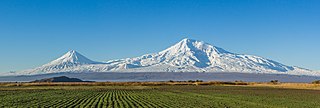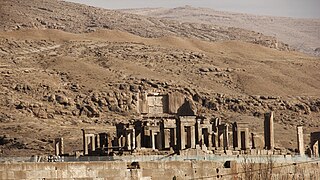
Shiraz is the fifth-most-populous city of Iran and the capital of Fars Province. At the 2016 census, the population of the city was 1,869,001 and its built-up area with "Shahr-e Jadid-e Sadra" was home to 1,565,572 inhabitants. Shiraz is located in the southwest of Iran on the "Rudkhaneye Khoshk" seasonal river. It has a moderate climate and has been a regional trade center for over a thousand years. Shiraz is one of the oldest cities of ancient Persia.
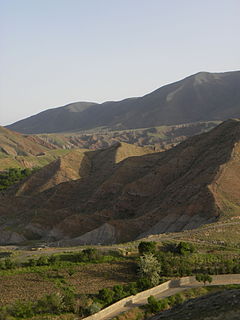
Nishapur or Nishabur is a city in Razavi Khorasan Province, capital of the Nishapur County and former capital of Province Khorasan, in northeastern Iran, situated in a fertile plain at the foot of the Binalud Mountains. It had an estimated population of 239,185 as of 2011 and its county 433,105. Nearby are the turquoise mines that have supplied the world with turquoise for at least two millennia. The city was founded in the 3rd century by Shapur I as a Sasanian satrapy capital. Nishapur later became the capital of Tahirid dynasty and was reformed by Abdullah Tahir in 830, and was later selected as the capital of Seljuq dynasty by Tughril in 1037. From the Abbasid era to the Mongol invasion of Khwarezmia and Eastern Iran, the city evolved into a significant cultural, commercial, and intellectual center within the Islamic world. Nishapur, along with Merv, Herat and Balkh were one of the four great cities of Greater Khorasan and one of the greatest cities in the middle ages, a seat of governmental power in eastern of caliphate, a dwelling place for diverse ethnic and religious groups, a trading stop on commercial routes from Transoxiana and China, Iraq and Egypt.

Kerman is the capital city of Kerman Province, Iran. At the 2011 census, its population was 821,374, in 221,389 households, making it the 10th most populous city of Iran.

A Persian carpet or Persian rug, also known as Iranian carpet, is a heavy textile made for a wide variety of utilitarian and symbolic purposes and produced in Iran, for home use, local sale, and export. Carpet weaving is an essential part of Persian culture and Iranian art. Within the group of Oriental rugs produced by the countries of the so-called "rug belt", the Persian carpet stands out by the variety and elaborateness of its manifold designs.

Khachmaz is one of administrative divisions of Azerbaijan. It is located about 10 km from the Caspian Sea, below Khudat, and to the east of Quba. Khachmaz is 170 kilometres north of the capital Baku. The Khachmaz rayon borders the Republic of Dagestan of the Russian Federation.

Bandar Torkaman, formerly known as Bandar Shah بَندَرِ شاه), is a city and capital of Torkaman County, Golestan Province, Iran. At the 2006 census its population was 45,045, in 9,755 families.

Zanjan is the capital of Zanjan Province in Iranian Azerbaijan. It lies 298 km (185 mi) north-west of Tehran on the main highway to Tabriz and Turkey and approximately 125 km (78 mi) from the Caspian Sea. The city is located about 20 kilometers south of the Qaflankuh Mountain Range. At the 2016 census, its population was 521,302 which is the 20th largest city in Iran. The population of Zanjan consists mostly of Iranian Azerbaijanis who speak the Azerbaijani language. Zanjan is 21733 square kilometers.

A Tabriz rug/carpet is a type in the general category of Persian carpets from the city of Tabriz, the capital city of East Azarbaijan Province in north west of Iran totally populated by Azerbaijanis. It is one of the oldest rug weaving centers and makes a huge diversity of types of carpets. The range starts at Bazaar quality of 24 raj and on up to the incredibly fine 110 raj. Raj are the units of knot density.
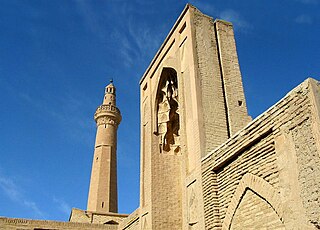
Nain is a city and capital of Nain County, Isfahan Province, Iran. At the 2011 census, its population was 25,379 in 7,730 families.

Kashan County is a county in Isfahan Province in Iran. The capital of the county is Kashan. At the 2006 census, the county's population was 297,000, in 81,816 families. The county is subdivided into four districts: the Central District, Qamsar District, Neyasar District, and Barzok District. The county has eight cities: Kashan, Meshkat, Barzok, Jowshaqan va Kamu, Damaneh, Neyasar, Qamsar & Kamu va Chugan.

Golpayegan County is a county in Isfahan Province in Iran. The capital of the county is Golpayegan. At the 2006 census, the county's population was 82,601, in 24,701 families. The county has one district: the Central District. The county has three cities: Golpayegan, Guged, and Golshahr.

Amol County is a county in Mazandaran Province in Iran. The capital of the county is Amol. At the 2006 census, the county's population was 343,747, in 93,194 families. The county is subdivided into three districts: the Central District, Larijan District, and Dabudasht District. The county has five cities: Amol, Rineh, Gazanak, Dabudasht & Amamzadeh Abdallah.

Meshgin Shahr is a city and capital of Meshgin Shahr County, in Ardabil Province, Iran. At the 2006 census, its population was 63,655, in 14,949 families.
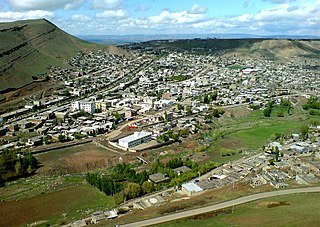
Germi is a city in and the capital of Germi County, Ardabil Province, Iran.

Kivi is a city in and the capital of Kowsar County, Ardabil Province, Iran. At the 2006 census, its population was 6,467, in 1,721 families. Earlier, Kivi was divided into upper and lower Kivi: düz kıvı and aşaği kıvı.

Farashband is a city and capital of Farashband County, Fars Province, Iran. At the 2006 census, its population was 17,142, in 3,762 families. It is located at an altitude of 775 metres (2,543 ft).

Ardabil is an ancient city in northwestern Iran, and the capital of Ardabil Province. Located in the northeastern part of Iran's historic Azerbaijan region, at the 2011 census, Ardabil's population was 564,365, in 156,324 families. The dominant majority in the city are ethnic Iranian Azerbaijanis and the primary language of the people is Azerbaijani.

Noqol is a village in Padena-ye Olya Rural District, Padena District, Semirom County, Isfahan Province, Iran. At the 2006 census, its population was 315, in 73 families.

Barak is a village in Arabkhaneh Rural District, Shusef District, Nehbandan County, South Khorasan Province, Iran. At the 2006 census, its population was 305, in 102 families.
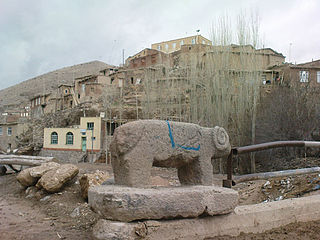
Majarshin is a village in Gonbar Rural District, in the Central District of Osku County, East Azerbaijan Province, Iran. At the 2011 census, its population was 1,112, in 304 families.


